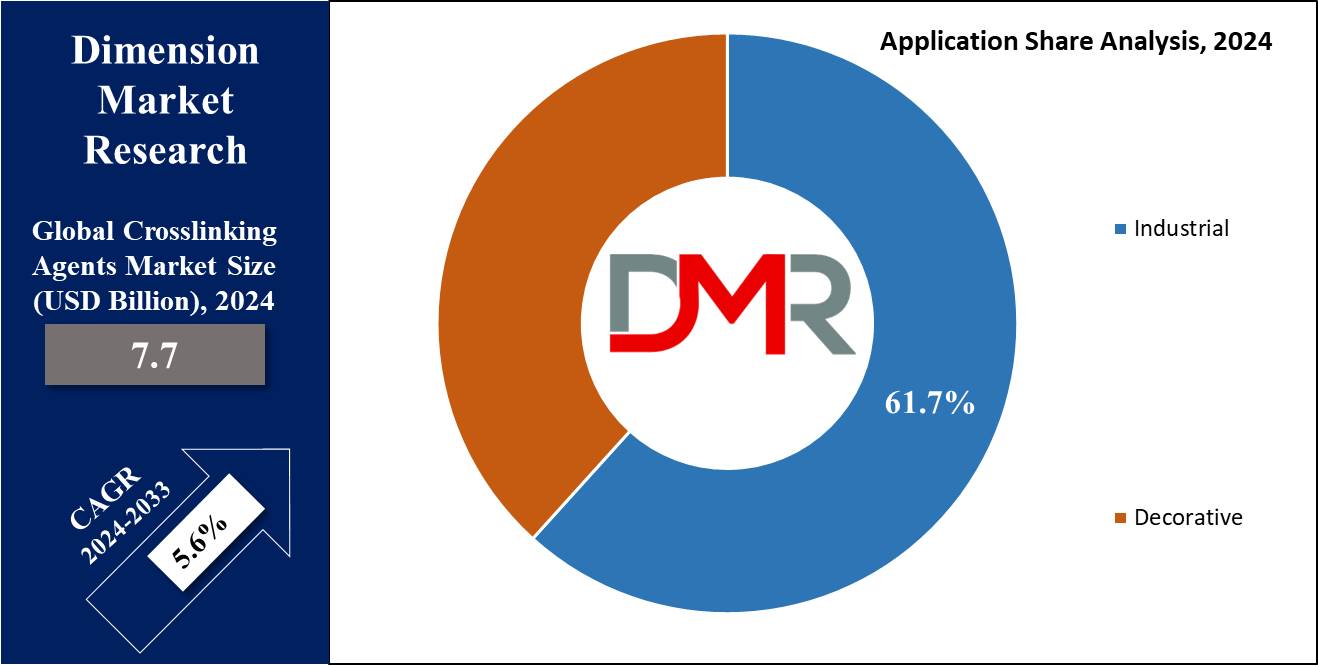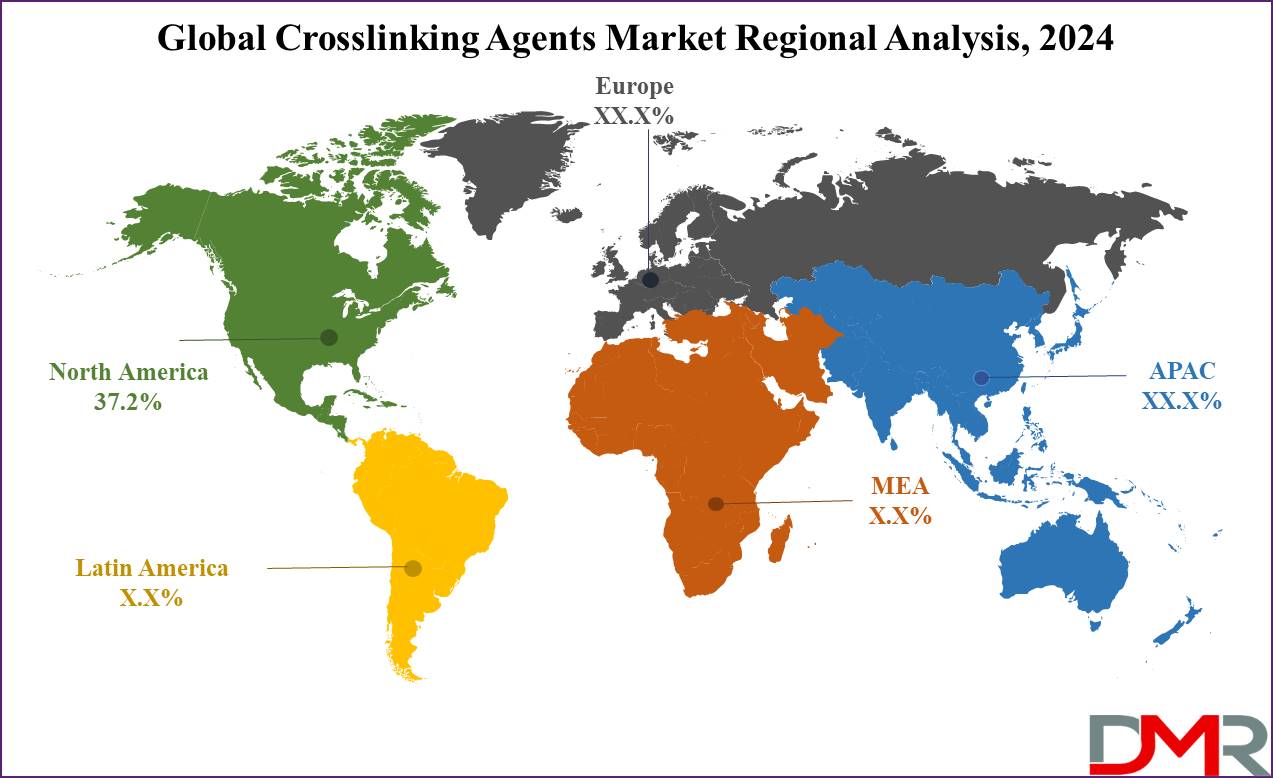Market Overview
The Global
Crosslinking Agents Market is expected to reach a valuation of
USD 7.7 billion in 2024 and is anticipated to achieve a remarkable
CAGR of 5.6% for the forecast period to reach a
value of 12.6 billion in 2033.
Crosslinking agents are molecules that support the formation of covalent bonds (crosslinks) between polymer chains, either during polymerization or through post-polymerization reactions. These bonds develop a network structure within the polymer matrix, imparting desirable properties like increased strength, rigidity, toughness, and dimensional stability.
These agents are commonly used in the production of thermosetting resins like epoxy, polyester, polyurethane, and phenolic resins. These resins encounter crosslinking reactions upon curing, resulting in durable and heat-resistant materials used in coatings,
adhesives, composites, and molded parts.
Further, crosslinking agents play a vital role in the formulation of adhesives and sealants, where they promote the formation of strong bonds between substrate surfaces. Crosslinked adhesives & sealants provide better adhesion, cohesion, and resistance to environmental factors such as temperature, moisture, and chemicals.
Key Takeaways
- Market Growth: The Crosslinking Agents Market size is expected to grow by 4.5 billion, at a CAGR of 5.6% during the forecasted period of 2025 to 2033.
- By Chemistry: The amide-based crosslinking segment is expected to lead in 2024 with a major & is anticipated to dominate throughout the forecasted period.
- By Application: The industrial application segment is expected to get the largest revenue share in 2024 in the Crosslinking Agents market.
- Regional Insight: North America is expected to hold a 37.2% share of revenue in the Global Crosslinking Agents Market in 2024.
- Use Cases: Some of the use cases of Crosslinking Agents include biomedical applications, polymer manufacturing, and more.
Use Cases
- Drug Delivery Systems: Amide-based crosslinking agents are used to create stable nanocarriers for targeted drug delivery, ensuring controlled and efficient release of therapeutic agents.
- Coatings and Adhesives: Isocyanate-based crosslinking agents enhance the durability, strength, and environmental resistance of coatings and adhesives used in automotive, construction, and industrial applications.
- Biomedical Applications: Crosslinking agents are crucial in the development of biocompatible materials for medical devices, tissue engineering, and nanogels for numerous biomedical applications.
- Polymer Manufacturing: They are critical in producing high-performance polymers, like polyurethanes and polyureas, used in various industries like electronics, textiles, and packaging.
Market Dynamic
Driving Factors
Industrial DemandThe increase in the need for high-performance materials in industries like automotive, construction, electronics, and
healthcare drives the need for crosslinking agents, which improve durability, strength, and environmental resistance.
Regulatory Support and Innovation
Favorable regulations, like the FDA’s approval of safe crosslinking agents for food contact applications, along with ongoing innovations in environmentally friendly & efficient crosslinking technologies, are major drivers of market growth.
Restraints
Environmental and Health Concerns
The use of certain crosslinking agents, mainly isocyanates, can create environmental and health risks, causing strict regulations and potential market limitations.
High Production Costs
The manufacturing of high-quality crosslinking agents can be costly, potentially limiting their adoption, mainly in price-sensitive markets or industries with tight budget constraints.
Opportunities
Biomedical Applications
There is an increase in opportunity in the biomedical sector for crosslinking agents due to higher demand for biocompatible materials, drug delivery systems, and tissue engineering applications.
Technological AdvancementsOpportunities lie in developing new formulations & technologies that enhance the efficiency,
safety, and environmental sustainability of crosslinking agents, thereby expanding their application potential across different industries.
Trends
Shift towards Green ChemistryThere is a major trend towards developing crosslinking agents that are environmentally friendly, biodegradable, and safer for human health, driven by regulatory pressures & consumer need for sustainable products.
Increasing Application in 3D Printing
Crosslinking agents are being increasingly utilized in additive manufacturing (3D printing) processes to improve the mechanical properties, durability, and versatility of printed materials, opening new avenues in manufacturing and prototyping.
Research Scope and Analysis
By Chemistry
The amide-based crosslinking type segment is expected to lead the market due to various advantages, mostly in biomedical applications. Amide crosslinking agents are important in producing nanogels, where stable amide bonds are formed. These agents are vital in drug delivery, acting as nanocarriers where ester bonds might hydrolyze to release drugs, but amide bonds provide simpler and more stable delivery methods. Mostly known as peptide bonds, amide bonds are integral to many fields like bioengineering, chemistry, and pharmacy. Their applications span biochemistry, polymers, drug discovery, and chemical synthesis, playing a critical role in biomolecule composition & various therapeutically approved drugs. These factors drive the growth of the amide-based crosslinking agents segment and boost the overall crosslinking agents market.
Further, the isocyanate-based crosslinking agent segment is the fastest-growing during the forecast period. Isocyanate-based crosslinking agents are mostly used across multiple applications, like copolymers, polyisocyanurates, polyureas, and polyurethanes. They are vital in products such as insulation foam, elastomers, sealants, thermoplastics, clothing fibers, adhesives, rubber processing equipment, and coatings for the automotive and construction industries. In addition, isocyanates are used in preparing microcapsules through interfacial or in-situ polymerization and in wood adhesives for furniture, utilizing plant-based castor oil to modify water-dispersible isocyanates. They are also used in silica aerosol monoliths. These applications drive the growth of the isocyanate-based crosslinking agents segment, further contributing to the expansion of the crosslinking agents market.
By Application
The crosslinking agent market is anticipated to be led by the industrial application segment in 2024, driven by its large use in industries like automotive, aerospace, electronics, and construction. These sectors need high-performance crosslinked materials for their exceptional durability, strength, and resistance to environmental factors, boosting the need for crosslinking agents. Further, the decorative application segment is also rapidly expanding, driven by the growth in the demand for crosslinked coatings and finishes in decorative and architectural applications, like furniture, flooring, and interior surfaces. Both consumers and industries are highly looking for decorative materials that provide better durability, scratch resistance, and color retention, which promotes the use of crosslinking agents in this segment.

The Crosslinking Agents Market Report is segmented on the basis of the following
By Chemistry
- Amine
- Amino
- Amide
- Aziridine
- Carbodiimide
- Isocyanate
- Others
By Application
- Industrial
- Transportation Coatings
- Industrial Wood Coatings
- Protective Coatings
- Marine Coatings
- Can/Coil Coatings
- General Industrial Coating
- Others
- Decorative
Regional Analysis
North America is expected to dominate the crosslinking agents market,
holding a 37.2% share, which is driven by high demand across various industries like healthcare, packaging, electronics, construction, and automotive. The United States, in general, is leading this growth. For instance, in December 2023, the U.S. Food and Drug Administration provided updated regulations in the eCFR (Electronic Code of Federal Regulations) regarding the usage of substances, like crosslinking agents and catalysts for epoxy resins, in coatings deemed safe for food contact, which is further drives market growth in the region.

Further, the Asia Pacific region is projected to be the fastest-growing market during the forecast period. The high use of natural crosslinking agents, which are environmentally friendly & safe for human health, drives this growth. Major contributors to this expansion are India & China, where large populations increasing the need for construction and other industries requiring crosslinking agents. China's strong economy, the largest in the region, plays a major role in this growth. Key sectors like manufacturing, mining, construction, textiles, automotive, electronics, and pharmaceuticals contribute to the strong demand for crosslinking agents, fueling market expansion in the Asia Pacific.
By Region
North America
Europe
- Germany
- The U.K.
- France
- Italy
- Russia
- Spain
- Benelux
- Nordic
- Rest of Europe
Asia-Pacific
- China
- Japan
- South Korea
- India
- ANZ
- ASEAN
- Rest of Asia-Pacific
Latin America
- Brazil
- Mexico
- Argentina
- Colombia
- Rest of Latin America
Middle East & Africa
- Saudi Arabia
- UAE
- South Africa
- Israel
- Egypt
- Rest of MEA
Competitive Landscape
The competitive landscape of the crosslinking agents market is characterized by a diverse number of players striving to innovate & expand their product offerings. Key strategies like R&D to improve product performance and meet regulatory standards, strategic partnerships to access new markets or technologies, and investments in eco-friendly solutions to meet higher environmental concerns. Companies focus on differentiation through technological development and customization to meet specific industry demands like automotive, healthcare, and construction, ensuring robust competition in this dynamic market.
Some of the prominent players in the global Crosslinking Agents Market are
- BASF SE
- Kaneka Corporation
- Mitsui Chemicals Inc
- Solenis LLC
- Allnex Group
- Aditya Birla Corporation
- Ineos
- H.B Fuller Company
- Lord Corporation
- Wacker Chemie AG
- Other Key Players
Recent Developments
- In April 2024, Iridium Communications Inc. announced that the company completed its acquisition of Satelles, Inc. The closing of this acquisition establishes Iridium as the leader in highly secure satellite-based time and location services that complement and secure GPS and other GNSS-reliant systems.
- In March 2024, the latest method to solubilize solid state crosslinking agents of thin film composite membranes for the uniform reactions review article was published for organic solvent reverse osmosis separations, which is useful in the pharmaceutical, chemical, and petrochemical industries.
- In January 2023, BASF announced that it would expand its current isocyanate production capacity to approximately 600,000 metric tons per year.
- In October 2022, BASF and King Steel Machinery signed a JDA to produce energy-saving processes that permit the manufacturing of 100 percent recyclable products which leads to an increase in industrial needs like household products, sports gear, toys, auto parts, and footwear. Chemical crosslinking agents are used.
Report Details
| Report Characteristics |
| Market Size (2024) |
USD 7.7 Bn |
| Forecast Value (2033) |
USD 12.6 Bn |
| CAGR (2024-2033) |
5.6% |
| Historical Data |
2018 – 2023 |
| Forecast Data |
2024 – 2033 |
| Base Year |
2023 |
| Estimate Year |
2024 |
| Report Coverage |
Market Revenue Estimation, Market Dynamics, Competitive Landscape, Growth Factors and etc. |
| Segments Covered |
By Chemistry (Amine, Amino, Amide, Aziridine, Carbodiimide, Isocyanate, and Others), By Application (Industrial and Decorative) |
| Regional Coverage |
North America – The US and Canada; Europe – Germany, The UK, France, Russia, Spain, Italy, Benelux, Nordic, & Rest of Europe; Asia- Pacific– China, Japan, South Korea, India, ANZ, ASEAN, Rest of APAC; Latin America – Brazil, Mexico, Argentina, Colombia, Rest of Latin America; Middle East & Africa – Saudi Arabia, UAE, South Africa, Turkey, Egypt, Israel, & Rest of MEA
|
| Prominent Players |
BASF SE, Kaneka Corporation, Mitsui Chemicals Inc, Solenis LLC, Allnex Group, Aditya Birla Corporation, Ineos, H.B Fuller Company, Lord Corporation, Wacker Chemie AG, and Other Key Players |
| Purchase Options |
HVMN Inc., Thync Global Inc., Apple Inc., Fitbit Inc., TrackmyStack, OsteoStrong, The ODIN, Thriveport LLC, Muse, Moodmetric, and Other Key Players |
Frequently Asked Questions
The Global Crosslinking Agents Market size is expected to reach a value of USD 7.7 billion in 2024 and is expected to reach USD 12.6 billion by the end of 2033.
North America is expected to have the largest market share in the Global Crosslinking Agents Market with a share of about 37.2% in 2024.
Some of the major key players in the Global Crosslinking Agents Market are BASF SE, Kaneka Corporation, Mitsui Chemicals Inc, and others.
The market is growing at a CAGR of 5.6 percent over the forecasted period.